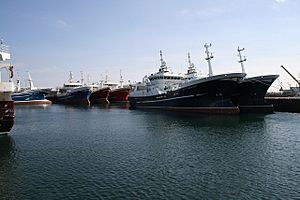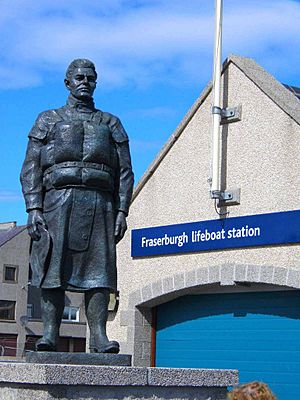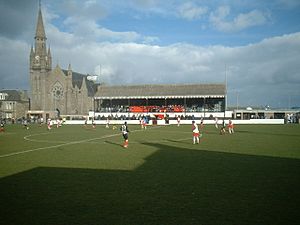Fraserburgh facts for kids
Quick facts for kids Fraserburgh |
|
|---|---|
 |
|
 Fishing boats in Fraserburgh harbour |
|
| Population | 12,570 (2020) |
| OS grid reference | NJ997670 |
| • Edinburgh | 128 mi (206 km) |
| • London | 434 mi (698 km) |
| Council area | |
| Lieutenancy area | |
| Country | Scotland |
| Sovereign state | United Kingdom |
| Post town | FRASERBURGH |
| Postcode district | AB43 |
| Dialling code | 01346 |
| Police | Grampian |
| Fire | Grampian |
| Ambulance | Scottish |
| EU Parliament | Scotland |
| UK Parliament |
|
| Scottish Parliament |
|
| Website | visitfraserburgh.com |
Fraserburgh, also known as the Broch, is a town in Aberdeenshire, Scotland. In 2011, about 13,100 people lived there. It's located in the northeast part of the county, about 40 miles (64 km) north of Aberdeen. Fraserburgh is Scotland's biggest port for shellfish and one of the largest in Europe. It's also a major port for other types of fish, like whitefish and pelagic fish.
Contents
History of Fraserburgh
Early Days: 1500s and 1600s
The town gets its name from the Fraser family. They bought the land in 1504 and made many improvements.
Around 1570, the Fraser family built Fraserburgh Castle at Kinnaird Head. A church was built nearby a year later. In 1579, Sir Alexander Fraser built a port. In 1588, he got permission to make Fraserburgh a "burgh of barony," which meant it was a town with special rights. In 1592, the town's name officially changed from Faithlie to Fraserburgh.
In 1595, Sir Alexander Fraser received a grant from the Parliament of Scotland to build a college. In 1597, the General Assembly of the Church of Scotland chose Rev. Charles Ferm to be its first leader.
Fraserburgh became a "burgh of regality" in 1601, giving it even more power. However, the college closed about ten years later. It was used again briefly in 1647 when King's College, Aberdeen moved there because of a plague. You can see a plaque about the university at the Fraserburgh Heritage Centre.
Growing Bigger: 1700s and 1800s
During the 18th and 19th centuries, Fraserburgh's population grew. Many people came for seasonal jobs. In 1755, about 1,682 people lived there, and by 1780, it was around 2,000.
In 1787, Fraserburgh Castle was turned into Kinnaird Head Lighthouse. This was Scotland's first lighthouse on the mainland.
In the 1790s, the local church minister, Rev. Alexander Simpson, said the harbour was "small but good." He noted that shipbuilding was the main industry. Locals wanted to make the harbour bigger.
The original church building was replaced and made larger in 1803. It could seat 1,000 people. The harbour was also extended with new piers built between 1807 and 1818.
Fraserburgh's population grew a lot in the early 1800s, from 2,271 in 1811 to 2,954 by 1831. This was mainly because of the growth in herring fishing, which became very popular after 1815. The herring season brought 1,200 more workers to the area. People noticed more wealth, better clothes and food, and many new houses being built.
More than £30,000 was spent on the harbour between 1807 and 1840. By then, it could hold many fishing boats.
Fraserburgh Town House, designed by Thomas Mackenzie, was finished in 1855.
Lifeboat Service
Fraserburgh has had a local lifeboat service since 1806. It was first run by the Harbour Board. The first official RNLI station in Scotland opened here in 1858.
In 2009, people in Fraserburgh started a campaign to raise money for a monument. They wanted to remember the 14 men who lost their lives while serving on the Fraserburgh Lifeboat. They raised £40,000, and the monument was unveiled in August 2010.
Railways
Fraserburgh railway station opened in 1865. It closed to passengers in 1965. The railway line connected Fraserburgh to Aberdeen and a short branch line to St Combs.
Passenger trains stopped running in 1965. Freight trains continued until 1979, and then the tracks were removed.
After the Borders Railway opened in 2015, Fraserburgh became the town furthest from a railway line in the UK. This led to calls for the old tracks to be put back. The closest working station now is Inverurie, about 35 miles (56 km) away.
Climate
Fraserburgh has a marine climate. This means the weather is greatly affected by the nearby sea. Summers are mild, and winters are not too cold for a place so far north. The temperature doesn't change much between seasons. For example, February averages 6.7°C (44.1°F), and August averages 17.2°C (63.0°F).
Because of the sea, there's a "seasonal lag." This means September is often warmer than June, and October nights can be milder than May nights, even though the days are shorter. The climate is often cloudy and wet, with about 1,351.8 hours of sunshine each year.
Fraserburgh also holds a UK weather record. On February 13, 1989, a wind gust of 142 mph (229 kph) was recorded at Kinnaird Head Lighthouse. This is the highest wind speed ever recorded in the UK at a low height.
| Climate data for Fraserburgh (14 m asl, averages 1981–2010) | |||||||||||||
|---|---|---|---|---|---|---|---|---|---|---|---|---|---|
| Month | Jan | Feb | Mar | Apr | May | Jun | Jul | Aug | Sep | Oct | Nov | Dec | Year |
| Record high °C (°F) | 14.2 (57.6) |
14.6 (58.3) |
17.7 (63.9) |
21.0 (69.8) |
22.5 (72.5) |
25.2 (77.4) |
26.6 (79.9) |
24.9 (76.8) |
23.7 (74.7) |
19.4 (66.9) |
17.9 (64.2) |
14.9 (58.8) |
26.6 (79.9) |
| Mean daily maximum °C (°F) | 6.9 (44.4) |
6.7 (44.1) |
8.2 (46.8) |
9.8 (49.6) |
12.3 (54.1) |
14.4 (57.9) |
16.8 (62.2) |
17.2 (63.0) |
14.9 (58.8) |
12.3 (54.1) |
9.4 (48.9) |
7.5 (45.5) |
11.4 (52.5) |
| Mean daily minimum °C (°F) | 2.4 (36.3) |
2.2 (36.0) |
2.7 (36.9) |
4.3 (39.7) |
6.6 (43.9) |
9.0 (48.2) |
11.0 (51.8) |
11.4 (52.5) |
9.4 (48.9) |
6.9 (44.4) |
4.6 (40.3) |
3.1 (37.6) |
6.1 (43.0) |
| Record low °C (°F) | −12.5 (9.5) |
−14.8 (5.4) |
−10.2 (13.6) |
−4.3 (24.3) |
−2.1 (28.2) |
−0.3 (31.5) |
3.2 (37.8) |
2.7 (36.9) |
−1.3 (29.7) |
−4.6 (23.7) |
−8.8 (16.2) |
−12.0 (10.4) |
−14.8 (5.4) |
| Average precipitation mm (inches) | 65.2 (2.57) |
54.4 (2.14) |
55.6 (2.19) |
58.4 (2.30) |
49.0 (1.93) |
48.0 (1.89) |
62.9 (2.48) |
51.2 (2.02) |
62.3 (2.45) |
89.7 (3.53) |
82.7 (3.26) |
68.3 (2.69) |
747.7 (29.44) |
| Mean monthly sunshine hours | 41.8 | 73.6 | 113.4 | 145.8 | 198.5 | 168.5 | 160.6 | 161.6 | 126.8 | 85.4 | 48.7 | 27.2 | 1,351.8 |
| Source: Met Office | |||||||||||||
People of Fraserburgh
In 2011, Fraserburgh had 13,180 residents. This made it the third largest town in Aberdeenshire. After 2004, many people from Poland and other eastern European countries moved to the town. Now, 5% of residents speak Polish as their main language.
About 10% of people in Fraserburgh speak the Scots language at home.
Places to Visit
Fraserburgh has many interesting places to see. These include an award-winning beach and a large commercial harbour. You can also visit Kinnaird Head Lighthouse and the Museum of Scottish Lighthouses. The Fraserburgh Heritage Centre tells the town's story. There is also a community war memorial by Scottish sculptor Alexander Carrick.
The town has several 19th-century churches, each with its own style. These include Fraserburgh Baptist Church, Fraserburgh Old Parish Church (the oldest), and Our Lady, Star of the Sea Roman Catholic Church.
Photo gallery
Sports and Fun
Fraserburgh has many sports facilities. These include a swimming pool, a ten-pin bowling alley, tennis courts, and football pitches. There's also a martial arts dojo and a skatepark.
Golf
Fraserburgh Golf Club was started in 1777. It is the fifth oldest golf club in Scotland and the seventh oldest in the world. It has an 18-hole course and a 9-hole course. There's also the Dunes Golf Centre nearby with a driving range.
Football
Fraserburgh Football Club plays in the Highland Football League. They won their fourth league title in April 2022. Fraserburgh United F.C. is another local football club.
Cricket
Fraserburgh Cricket Club was founded in 1862. They play in the Aberdeenshire Grades Leagues. In 2014, they reached the top league for the first time since 1975. The club has won the Bon Accord Cup three times, in 2013 and 2018.
Media
Television
Television signals come from the Durris TV transmitter and a local relay in Rosehearty.
Radio
You can listen to BBC Radio Scotland on 93.1 FM. Other stations include Greatest Hits Radio North East Scotland on DAB and MFR Radio on 96.7 FM.
Newspapers
The local newspaper for Fraserburgh is The Fraserburgh Herald.
Getting Around
Roads
Fraserburgh is at the northern end of the A90 road. Buses serve the town, including the Buchan Express to Aberdeen. There are also local bus services.
Harbour
Fraserburgh has a very busy commercial harbour. It is a major port for white fish. The harbour has a six-berth slipway, storm gates, a large drydock, and modern fish market facilities.
Education
Fraserburgh has several schools. There are four primary schools: Fraserburgh North School, Fraserburgh South Park School, Lochpots School, and St Andrew's School. The town also has a secondary school, Fraserburgh Academy, and a special needs school, Westfield School. You can also find a campus of North East Scotland College here.
Fraserburgh Academy
The original Fraserburgh Academy building opened in 1909. A newer school was built in the 1950s. The old building is now used for art and drama classes. Students from the school have won prizes in a national photography competition.
In 2009, a group of MPs from the Scottish Parliament held a meeting at the school. Also, the school's art department held a photo exhibition about Thomas Blake Glover, who was born in Fraserburgh. In September 2009, the famous Poet Laureate Carol Ann Duffy visited the school and gave a speech to students.
Religion
Christianity is the main religion in Fraserburgh. There are many different Christian churches in the town. These include three Church of Scotland churches and several Pentecostal churches. There are also Baptists, Roman Catholics, Scottish Episcopalians, Jehovah's Witnesses, and Salvationists.
Fraserburgh Junior Arts Society
In 1952, the Fraserburgh Photographic Society put on a pantomime to raise money. It was so successful that some members formed the Fraserburgh Junior Arts Society the next year. This group encourages young people in the arts. They put on pantomimes, plays, musicals, and variety shows.
In 1957, the society helped start a fund for a swimming pool after some accidents at the beach. The Fraserburgh swimming pool was finished in 1969. Many former members of the society have gone on to careers in drama, music, or dance.
Famous People from Fraserburgh
- James Cardno (1912–1975): A Scottish bobsledder who won a bronze medal at the 1936 Winter Olympics.
- Bill Gibb (1943–1988): A famous international fashion designer.
- Thomas Blake Glover (1838–1911): Born in Fraserburgh, he moved to Japan and helped bring modern industries there. He became a legend in Japan.
- Charles Jarvis (VC) (1881–1948): A soldier who received the Victoria Cross, a very brave award.
- Patrick "Pat" King (1944–2022): A Scottish bassist, known for playing with Manfred Mann's Earth Band.
- James Ramsay (1733–1789): Born in Fraserburgh, he was an important campaigner against slavery.
- Christian Watt (1833–1923): Author of "The Christian Watt Papers," which tells about life in the area.
Twin Towns
- Bressuire, France
See also
 In Spanish: Fraserburgh para niños
In Spanish: Fraserburgh para niños











